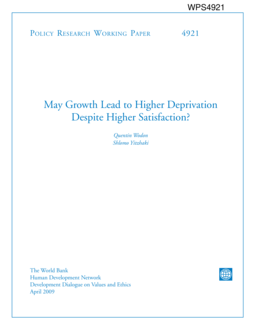Hello! You're looking at a policy document report on Overton
We track government policy, guidelines, think tank research, working papers and more to help our customers see the impact and influence of their work. Are you interested in seeing what information we have to offer? Request a free trial to our platform.
If you fund, produce or manage research or work to influence policy, we'd love to talk. Learn more on our homepage.

Identifiers
handle
10986/4111
May Growth Lead to Higher Deprivation Despite Higher Satisfaction?
Wodon, Quentin and Yitzhaki, Shlomo
In a relative deprivation framework, unless inequality is reduced, growth is associated with both higher satisfaction and higher deprivation. This may help explain the discontent with growth despite its benefits. As is well known in the literature, knowledge of the population's mean income and Lorenz curve is all that is needed to analyze a distribution, so that this can also be used to assess the satisfaction and deprivation of each individual. Given the normalization used to derive the satisfaction and deprivation measures, satisfaction and deprivation add up to the mean income for the population as a whole as well as for each individual.
Topics in this document
Economic development
Income
Economic equilibrium
Economy
Economics
Economic growth
Utility
Economic inequality
Poverty
Gini coefficient
Microeconomics
Market (economics)
Lorenz curve
Income distribution
Mean
Price
Supply and demand
Culture
Social welfare function
Assumption
Related SDGs
SDG 1: No Poverty ...
SDG 10: Reduced Inequality ...
SDG 1: No Poverty
Target 1.2
Reduce at least by half the proportion of men, women and children of all ages living in poverty in all its dimensions according to national definitions
SDG 10: Reduced Inequality
Target 10.1
Progressively achieve and sustain income growth of the bottom 40 per cent of the population at a rate higher than the national average
Citations
Cited by 1
other policy document
(0 of them are from other policy sources)
